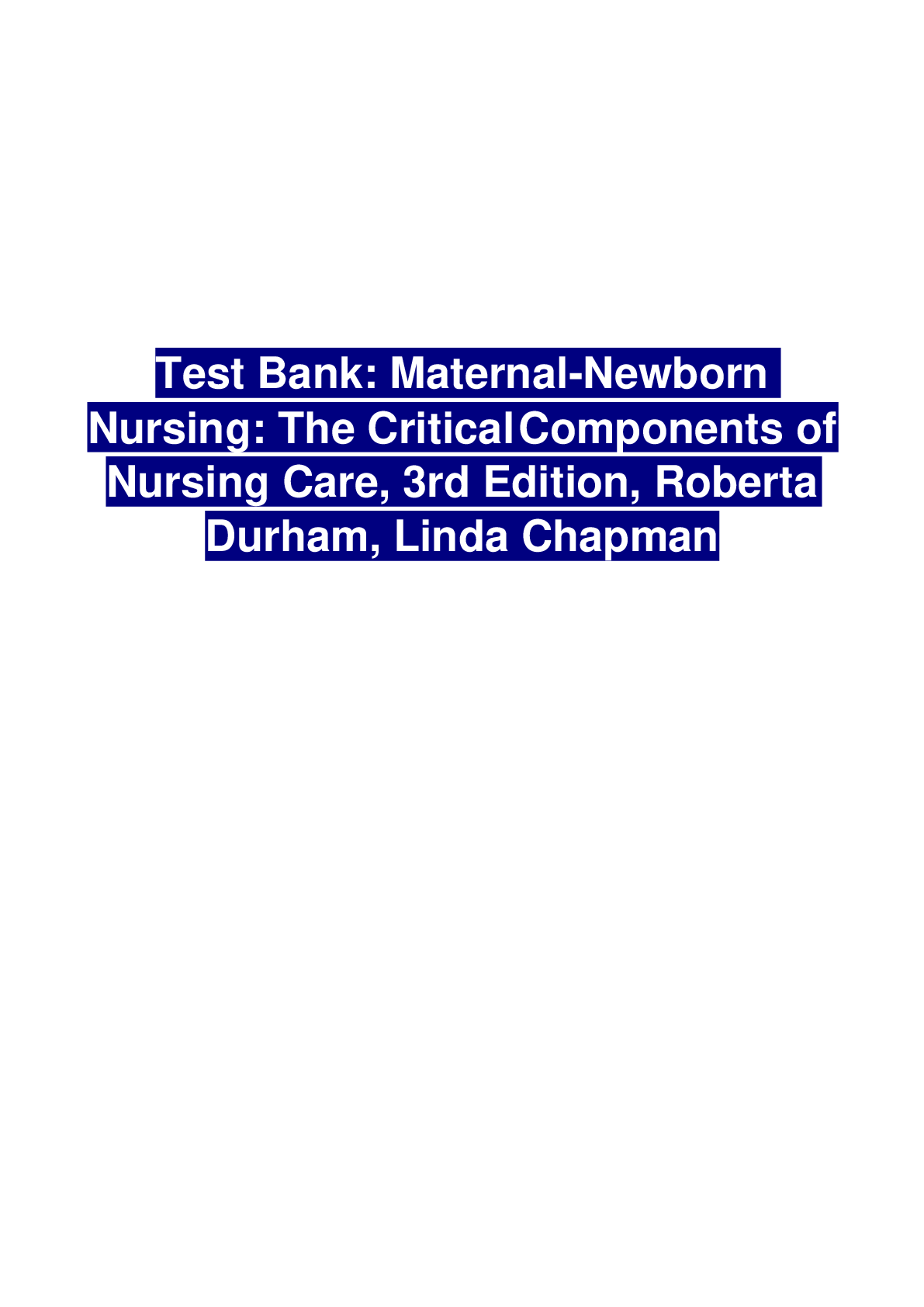*NURSING > EXAM > Test Bank Pediatric Nursing The Critical Components of Nursing Care 2nd Edition Kathryn Rudd/RATED A (All)
Test Bank Pediatric Nursing The Critical Components of Nursing Care 2nd Edition Kathryn Rudd/RATED A
Document Content and Description Below
Test Bank Pediatric Nursing The Critical Components of Nursing Care 2nd Edition Kathryn Rudd Chapter 1: Issues and Trends Multiple Choice 1. A 3-year-old is an inpatient on an orthopedic ... floor. The mother is participating in care as much as possible. The nurse knows that the participation of parents with the care of a child is known as: 2. A nurse is explaining the physical maturity of a 12-year-old boy to a nursing student. The nursing student knows that all except one the following areincluded in assessing physical maturity: 3. Promotion for family-centered care consists of all except one of the following strategies: 4. Culturally sensitive care is noted when a nurse: 1. Levi’s mother has requested a priest to baptize him during his hospitalization. Baptism in the Christian faith is seen as: 6. The leading infant mortality risk in the United States is: 7. The nurse is speaking to a group of teenagers about health promotion. The nurse knows the leading cause of mortality for this age range is: 8. A staff nurse explains relationship-based care to an inpatient daughter’s father as: 1. “Your family is one of many on this unit. We will work to take care of your daughter to the best of our ability.” 2. “You and your family are part of the plan of care so we all, staff and doctors, can meet the needs of your daughter.” 3. “I am sorry, but I do not have time to speak with you right now. I will have the charge nurse come answer your questions.” 4. “The staff values input and will ask you when we have questions about your daughter.” ANS: 2 Feedback 1. The comment is offhand and does not show the father that his daughter is going to receive individualized care, which is a major component of relationship-based care. 2. The nurse addresses the needs of the father at this time. 3. The nurse states that she does not have time, but by delegating this conversation to someone else, the father does not have a relationship with the nurse, which is not suitable. 4. The nurse did not allow the father to give input about his daughter freely. The nurse requires him to have permission. KEY: Content Area: Relationship | Integrated Processes: Communication/Documentation | Client Need: Psychosocial Integrity | Cognitive Level: Analysis | REF:Chapter 1 | Type: Multiple Choice 9. In the last 10 years in pediatric nursing, there has been an increase in: 1. Obesity. 2. Diabetes. 3. Hypertension. 4. All of the above. ANS: 4 Feedback 1. All have been increasing in the last 10 years. 2. All have been increasing in the last 10 years. 3. All have been increasing in the last 10 years. 4. Correct KEY: Content Area: Disease Processes | Integrated Processes: Nursing Process | Client Need: Physiological Integrity | Cognitive Level: Knowledge | REF:Chapter 1 | Type: Multiple Choice 10. The purpose of the Best Pharmaceuticals for Children Act of 2007 was: 1. To regulate the types of medications given to children. 2. To require manufacturers to test medication on children if the intention is for use with children. 3. To provide safety caps on all medications with children in the household. 4. To increase awareness of medication use in children. ANS: 2 Feedback 1. Medications were being given to children before the act was passed. 2. The testing done on children helps to predict the outcomes when used with other children. Up until this point, medications that were tested on adults were being used for children. 3. The act does not deal with home safety for medications. 4. The act does increase awareness, but is not the best answer for this question. KEY: Content Area: Legal | Integrated Processes: Nursing Process | Client Need: Safe and Effective Care Environment | Cognitive Level: Application | REF:Chapter 1 | Type: Multiple Choice 11. For which of the following is a master’s degree required? 1. Pediatric outpatient nurse 2. Pediatric intensive care unit nurse 3. Clinical nurse specialist 4. Home care nurse ANS: 3 Feedback 1. RN licensure required 2. RN licensure required 3. Master’s degree required 4. RN licensure required KEY: Content Area: Safe and Effective Care Environment | Integrated Processes: Teaching/Learning | Client Need: Safe and Effective Care Environment | Cognitive Level: Cognitive | REF:Chapter 1 | Type: Multiple Choice 12. A pediatric nurse with undergraduate preparation has a wide range of career opportunities, which might include the following: 1. Pediatric hospice nurse. 2. Neonatal nurse practitioner. 3. Pediatric nursing professor. 4. Pediatric clinical nurse specialist. ANS: 1 Feedback 1. Requires undergraduate preparation 2. Requires a graduate-level degree 3. Requires a graduate-level degree 4. Requires a graduate-level degree KEY: Content Area: Professionalism | Integrated Processes: Teaching/Learning | Client Need: Safe and Effective Care Environment | Cognitive Level: Application | REF:Chapter 1 | Type: Multiple Choice 13. A staff nurse may be required to complete additional training or certification for a pediatric unit, which might include: 1. Pediatric Advanced Life Support. 2. Certified Pediatric Oncology Nurse. 3. Certification for neonatal or pediatric critical care. 4. All of the above. ANS: 4 Feedback 1. PALs may be required for advanced training for a pediatric floor. 2. Certification may be required if the population base is high in oncology patients. 3. Neonatal or pediatric critical care certification may be required, in order to have highly trained individuals in the units. 4. All of the above-listed training and certifications might be required for a staff nurse. KEY: Content Area: Safe and Effective Care Environment | Integrated Processes: Teaching/Learning | Client Need: Safe and Effective Care Environment | Cognitive Level: Knowledge | REF:Chapter 1 | Type: Multiple Choice 14. Pediatric nurses are confronted with an increase in lifestyle-related illnesses of children, such as: 1. Diabetes. 2. Hypertension. 3. Obesity. 4. All of the above. ANS: 4 Feedback 1. Diabetes is a lifestyle-related illness for some children. 2. Hypertension is increasing in the population because of diet and lack of exercise. 3. Obesity is rising in children because of diet and exercise issues. 4. All of the responses are correct. Diabetes, hypertension, and obesity are all increasing lifestyle illnesses in children. KEY: Content Area: Health Promotion and Maintenance | Integrated Processes: Nursing Process | Client Need: Health Promotion and Maintenance | Cognitive Level: Analysis | REF:Chapter 1 | Type: Multiple Choice 15.The Best Pharmaceuticals for Children Act, the Pediatric Research Equity Act, and the Pediatric Medical Device Safety and Improvement Act enhance pediatric related research and practice by: 1. Not requiring parental consent. 2. Increasing the potential number of children included as research study participants. 3. Not requiring Hospital Institutional Review Boards to review research protocols. 4. Requiring consent from a close family member. ANS: 2 Feedback 1. Consent is required by the parents/guardian. 2. These acts have increased the potential number of children being included as research study participants. 3. Hospital Institutional Review Boards are required to review research proposals. 4. Consent is required by the parent or guardian. KEY: Content Area: Safety | Integrated Processes: Nursing Process | Client Need: Safe and Effective Care Environment | Cognitive Level: Comprehension | REF:Chapter 1 | Type: Multiple Choice 16.As a nursing student in a pediatric course, one should reasonably expect the following training: 1. Simulated-learning environments with infant/child human patient simulators and use of standardized patient scenarios. 2. Insurance approval mechanisms. 3. Health promotion and disease prevention. 4. 1 and 3. ANS: 1 Feedback 1. Simulation allows for nursing students to practice and have patients with situations that are not present during clinical times. 2. Insurance approval mechanisms are not typically covered in a pediatric nursing course. 3. Health promotion and disease prevention aid in decreasing issues related to illnesses that are preventable in children. 4. Simulation allows for nursing students to practice on and have patients with situations that are not present during clinical times. Health promotion and disease prevention aid in decreasing issues related to illnesses that are preventable in children. KEY: Content Area: Safety | Integrated Processes: Teaching/Learning | Client Need: Physiological Integrity | Cognitive Level: Knowledge | REF:Chapter 1 | Type: Multiple Choice 17. The prudent pediatric nurse must explore beyond the traditional view of culture as being simply ethnicity to deliver culturally sensitive care. Assessment of the patient/family should include: 1. Physical assessment. 2. Signed consent to treat. 3. Family constellation (blended, single parent, cohabitating, gay/lesbian, etc.). 4. Birth history. ANS: 3 Feedback 1. This should be included, but one must consider what is acceptable to the culture of the patient. 2. Consents are still required, but this does not include the factors of culture and ethnicity. 3. Family constellation (blended, single parent, cohabitating, gay/lesbian, etc.) should be considered in order to deliver culturally sensitive care. 4. Birth history is objective information; it does not, in itself, need to be considered to provide culturally sensitive care. KEY: Content Area: Culture| Integrated Processes: Nursing Process| Client Need: Psychosocial Integrity | Cognitive Level: Application | REF:Chapter 1 | Type: Multiple Choice 18. A trend of increased pediatric hospital admissions can be attributed to: 1. Fewer pediatricians. 2. Lack of primary care access. 3. Better health insurance coverage for children. 4. An increase in the environmental air quality. ANS: 2 Feedback 1. The number of pediatricians does not affect the number of hospital admissions. 2. Children who have not obtained primary care have been noted to be sicker when admitted to the hospital than those children who have received with primary care. 3. Hospital admissions have not been attributed to better insurance coverage for children. 4. Increased air quality does not increase pediatric hospital admissions. KEY: Content Area: Health | Integrated Processes: Nursing Process | Client Need: Safe and Effective Care Environment | Cognitive Level: Evaluation | REF:Chapter 1 | Type: Multiple Choice 19. Historically, early pediatric nursing care: 1. Included families in the plan of care and allowed one parent to be present with the child. 2. Employed relationship-based care. 3. Included flexibility in family visitation. 4. Was impersonal and focused primarily on preventing the spread of disease. ANS: 4 Feedback 1. Parents were not included in the decision making and were not allowed to be present with the child at all times. 2. Relationship-based care was not historically considered. 3. Visitation has historically been rigid. 4. Historically, pediatric care was impersonal and focused on preventing the spread of disease. KEY: Content Area: Health Care | Integrated Processes: Nursing Process | Client Need: Safe and Effective Care Environment | Cognitive Level: Evaluation | REF:Chapter 1 | Type: Multiple Choice 20. A pediatric nurse evaluating the state of evidence-based practices may be best served by reviewing peer-reviewed professional journals in addition to which of the following electronic resources? 1. Blogs regarding specific disease states 2. Agency for Healthcare Quality and Research 3. General search engine results 4. All of the above ANS: 2 Feedback 1. Blogs do not typically include evidence- based practice. 2. Agency for Healthcare Quality and Research provides peer-reviewed professional journals. 3. General search engines do not typically provide information to support evidence- based practice. 4. Blogs and general searches do not necessarily provide information on evidence-based practice. KEY: Content Area: Management of Care | Integrated Processes: Teaching/Learning | Client Need: Safe and Effective Care Environment | Cognitive Level: Knowledge | REF:Chapter 1 | Type: Multiple Choice 21.Relationship-based care expands care delivery beyond core concepts of family- centered care to include: 1. Informed consent that only includes the parent, regardless of age of the pediatric patient. 2. The nurse’s developing a relationship with family members through one-on-one conversations. 3. Focusing on identifying the relationship structure of the family. 4. Exclusion of siblings from the plan of care. ANS: 2 Feedback 1. Informed consent includes the parent and sometimes the child, depending on the the child’s age and mental status. 2. Relationship-based nursing includes one- on-one conversations with the family members. 3. Relationship-based nursing does not simply focus on identifying the structure of the family. 4. When appropriate, siblings can be included in the plan of care with relationship-based care. KEY: Content Area: Family Centered Care | Integrated Processes: Nursing Process | Client Need: Safe and Effective Care Management | Cognitive Level: Application | REF: Chapter 1 | Type: Multiple Choice 22. A nurse is aware that there will be a surgical pediatric patient admitted later in the day, but report has not been called yet. What is the most common surgical procedure for pediatric patients? 1. Internal fixation of fracture 2. Cleft lip and palate repair 3. Appendectomy 4. Myelomeningocele repair ANS: 3 Feedback 1. Fractures are not the most common surgical procedure. 2. A cleft lip and palate repair has a low occurrence . These are usually done in infancy. 3. An appendectomy is one of the most common pediatric surgeries. 4. A myelomeningocele repair occurs soon after birth and is not as common as an appendectomy. KEY: Content Area: Surgery | Integrated Processes: Nursing Process | Client Need: Physiological Integrity | Cognitive Level: Knowledge | REF: Chapter 1 | Type: Multiple Choice Multiple Response 23. Identify the statements that define the nursing profession. Select all that apply. 1. Development and publication of professional standards 2. Educational opportunities 3. Professional organizations 4. Medical research 5. Certifications of specialty areas ANS: 1, 2, 3, 5 Feedback 1. Part of the core standards 2. Part of the core standards 3. Part of the core standards 4. Medical research is not appropriate. The use of nursing research is needed. 5. Part of the core standards. KEY: Content Area: Professionalism | Integrated Processes: Nursing Process | Client Need: Psychosocial Integrity | Cognitive Level: Knowledge | REF: Chapter 1 | Type: Multiple Response [Show More]
Last updated: 1 year ago
Preview 1 out of 26 pages
Instant download
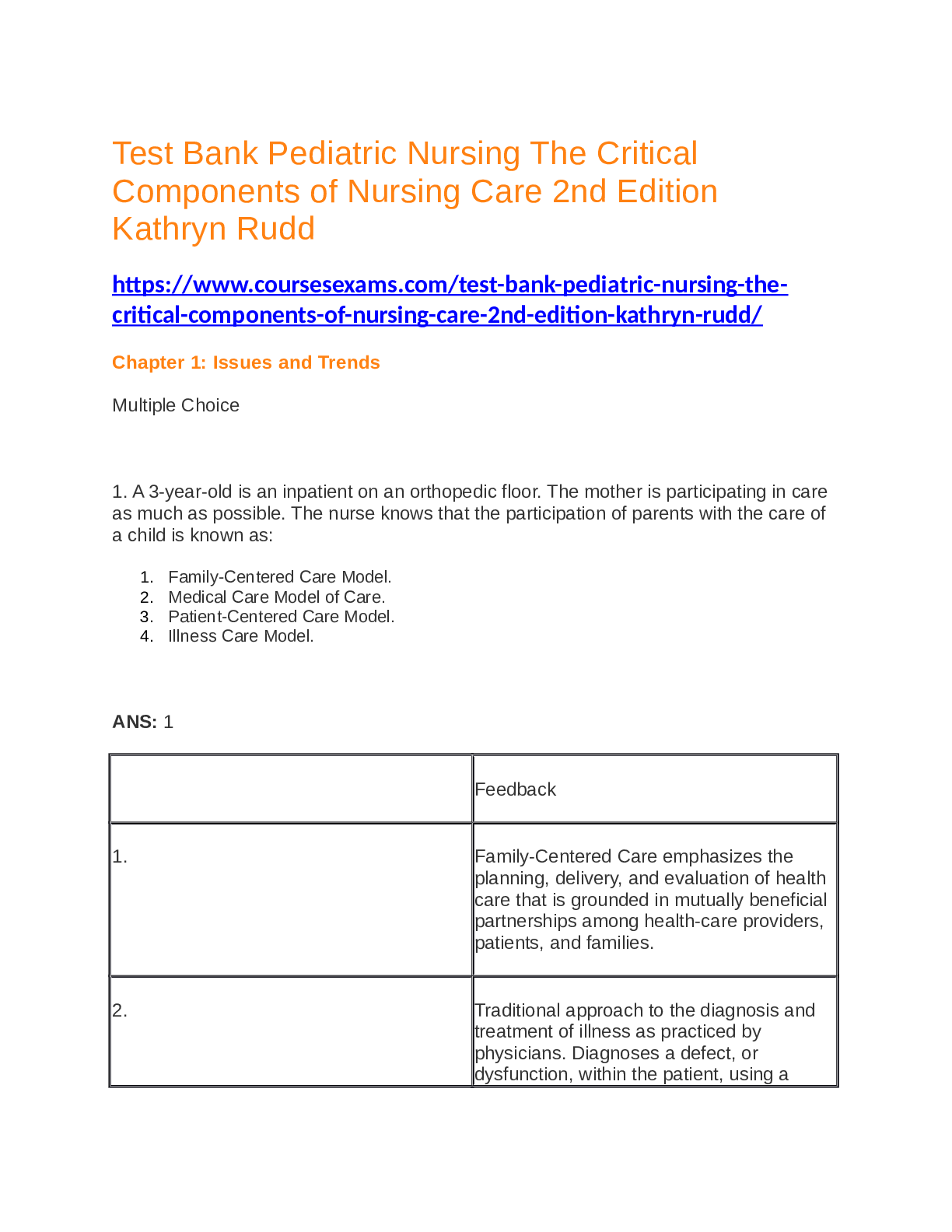
Buy this document to get the full access instantly
Instant Download Access after purchase
Add to cartInstant download
Reviews( 0 )
Document information
Connected school, study & course
About the document
Uploaded On
Jul 11, 2021
Number of pages
26
Written in
Additional information
This document has been written for:
Uploaded
Jul 11, 2021
Downloads
0
Views
33


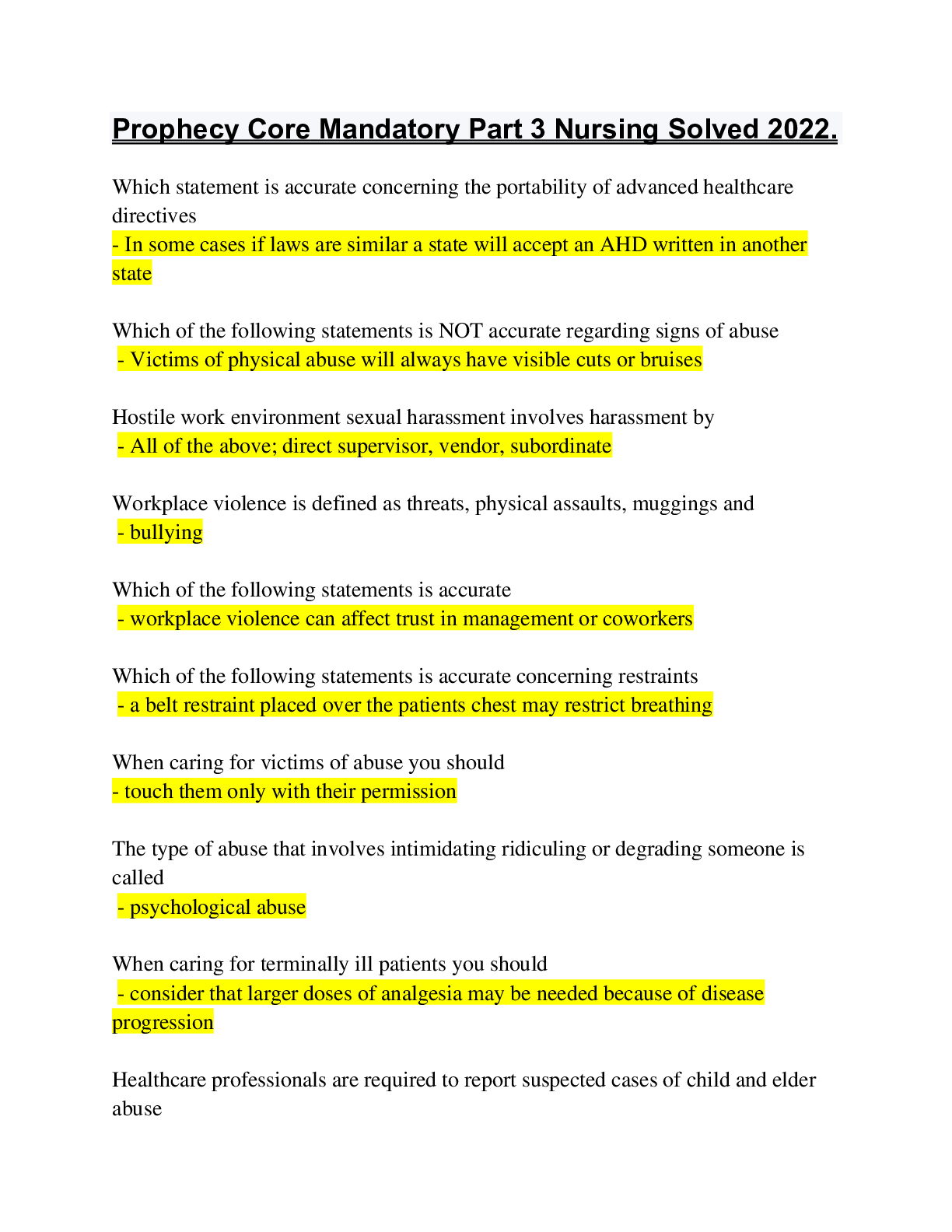
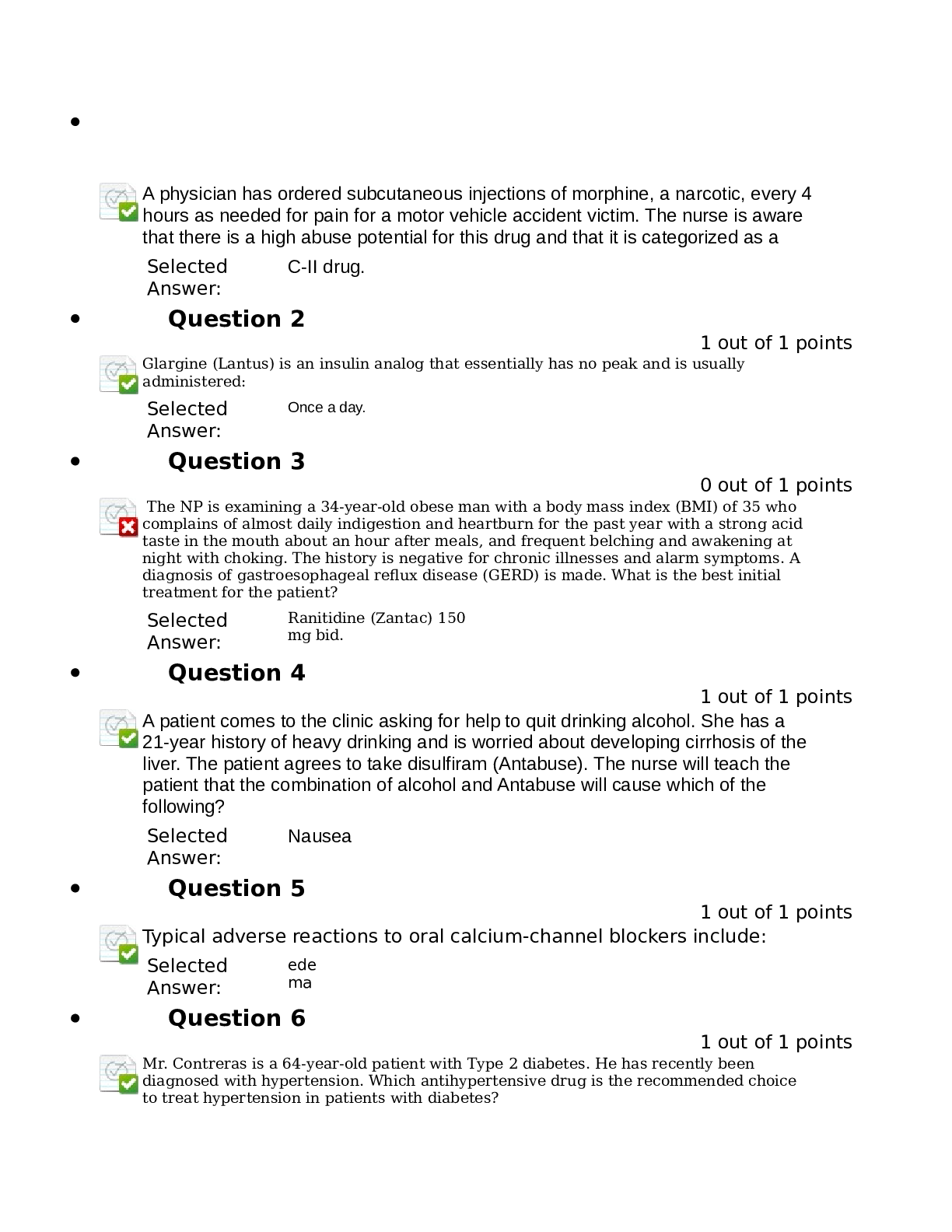
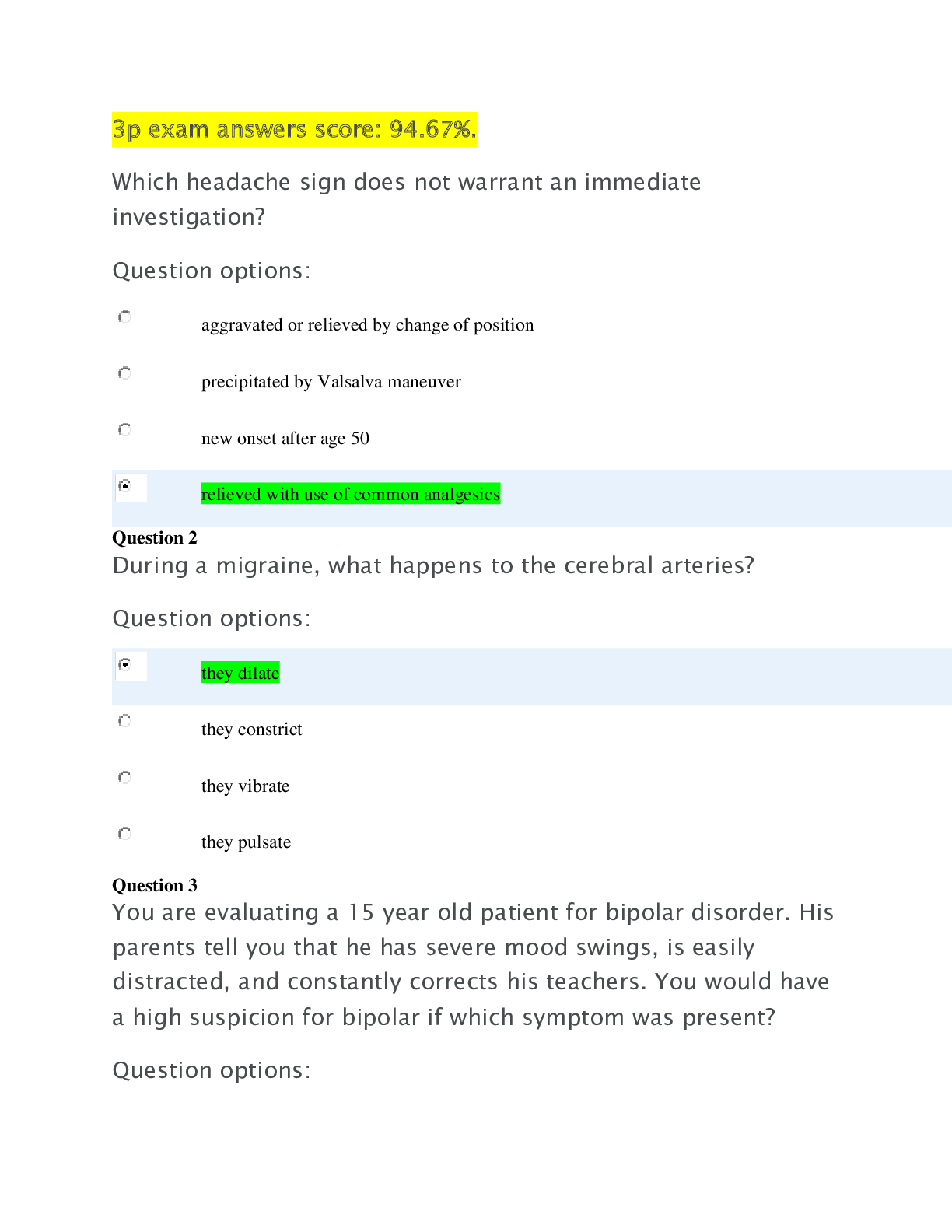




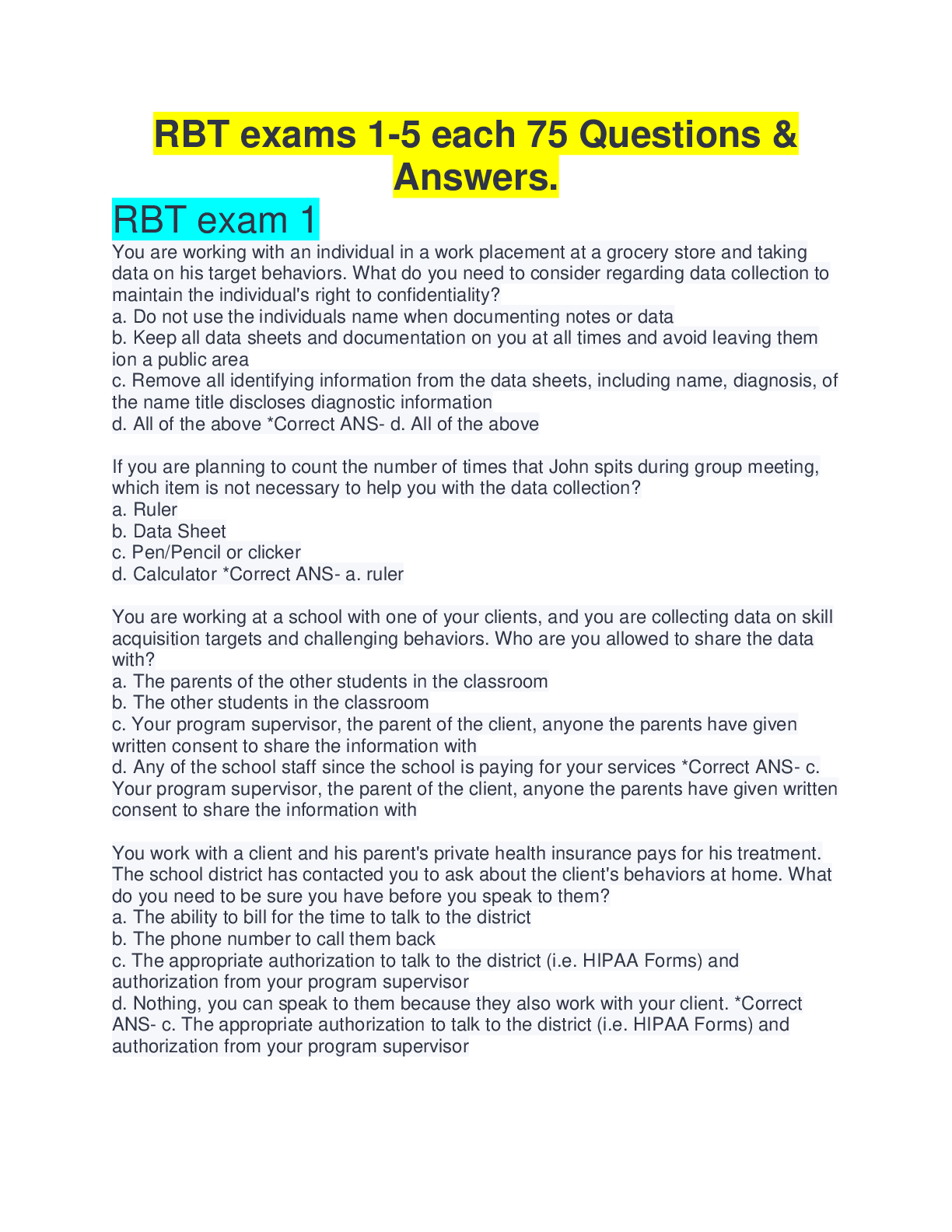
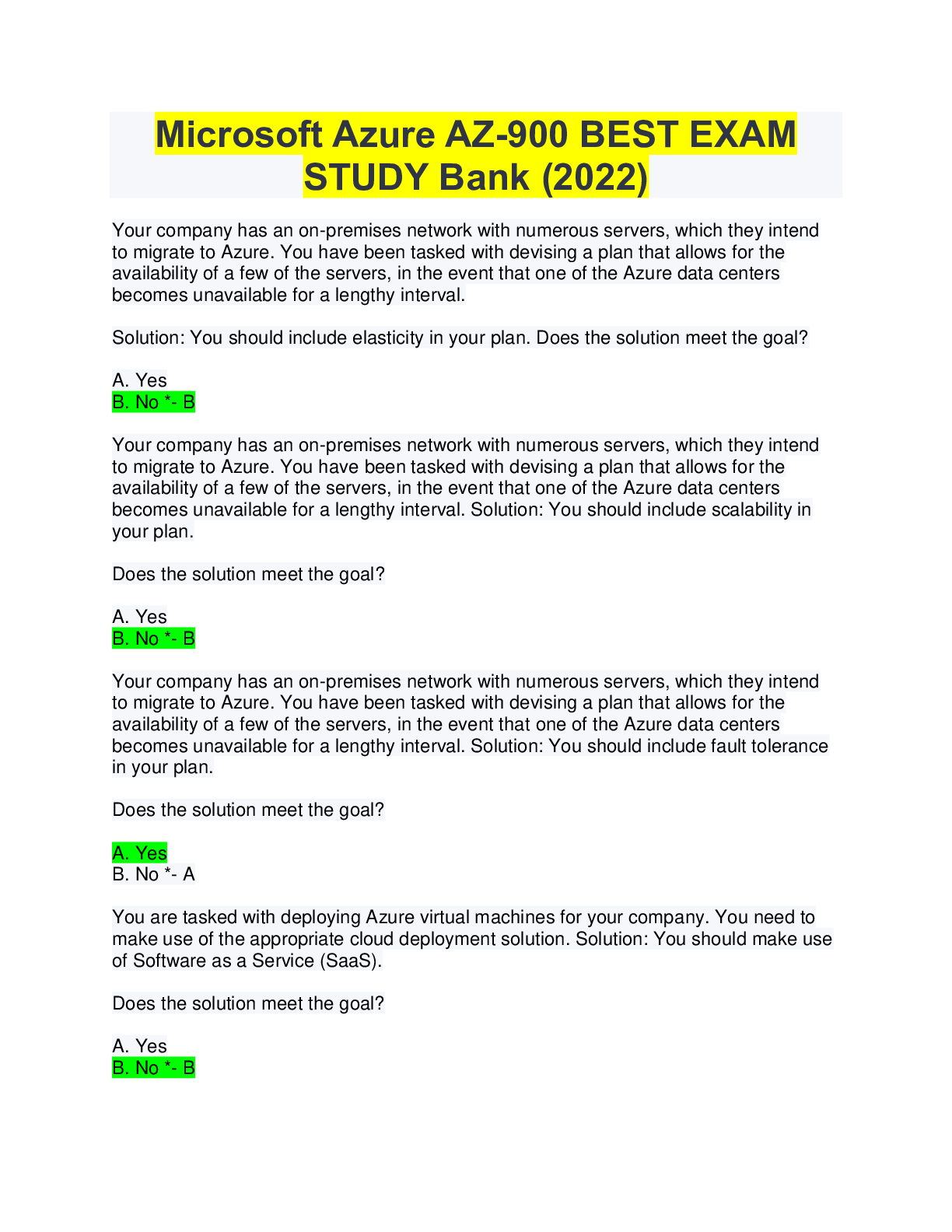
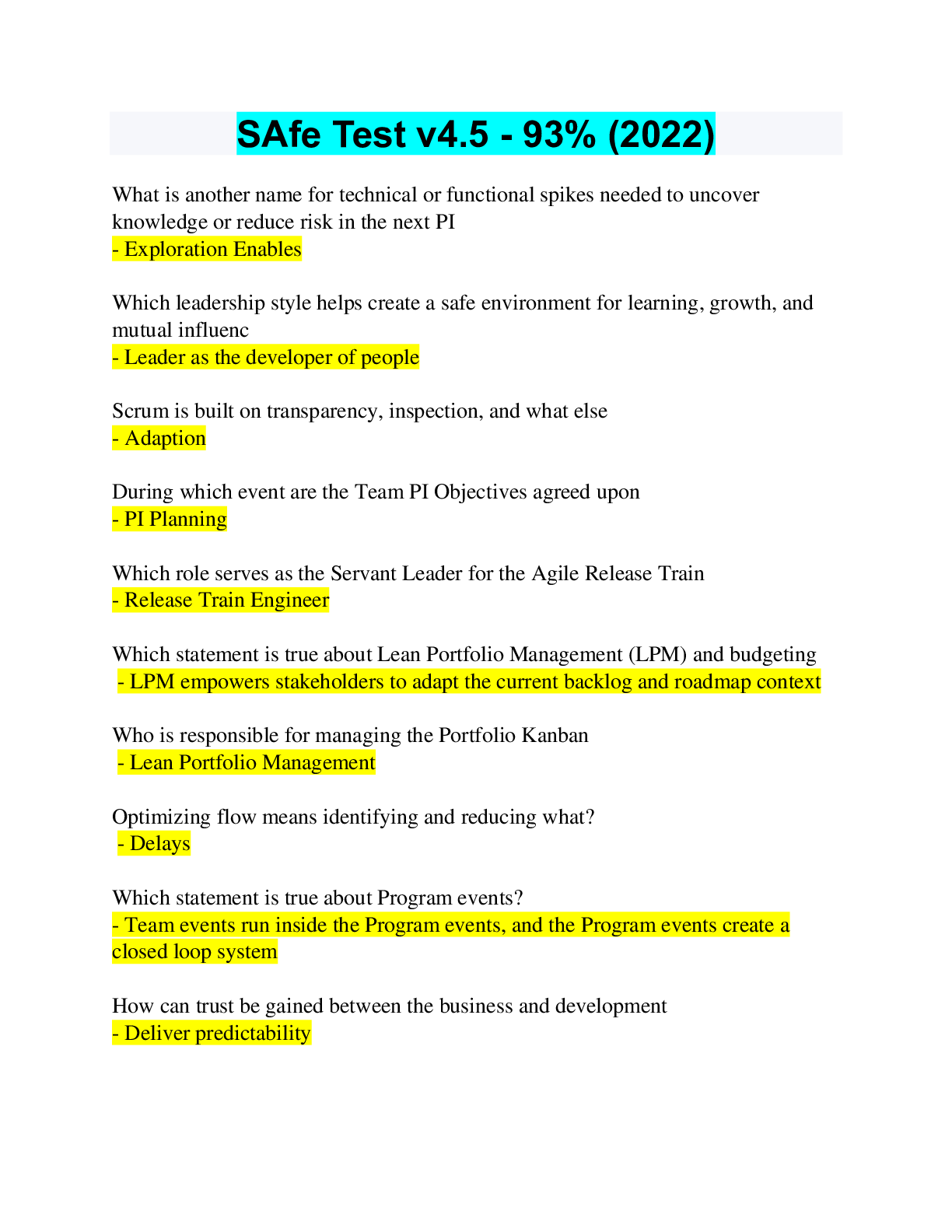


.png)
